While every respondent in this survey self-identifies as lesbian, gay, bisexual or transgender, they vary widely in the importance they attach to their own sexual orientation or gender identity and in the sense of community they share with other LGBT adults.
Some, including about half of gay men and lesbians, view their sexual orientation or gender identity as extremely or very important to their overall identity, but others say it carries relatively little weight.
LGBT adults also differ in how much they have in common with other subgroups within the LGBT population; how much they participate in activities such as LGBT pride events and rallies; and how big a role they believe that venues such as LGBT neighborhoods and bars should play in the future as their population becomes more accepted by the broader society.
Importance of Identity to LGBT Individuals
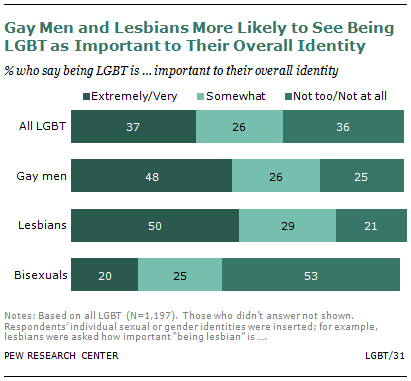
While 37% of LGBT adults say that being lesbian, gay, bisexual or transgender is “extremely” or “very” important to their overall identity, a similar share (36%) says it is “not too” or “not at all” important. About a quarter of LGBT adults (26%) fall in between—saying their LGBT identity is “somewhat important” to their overall identity.
Gay men and lesbians are far more likely than bisexuals to view their sexual orientation as important to their overall identity. About half of gay men (48%) say that being gay is extremely or very important to their overall identity; 50% of lesbians say being lesbian is extremely or very important to their overall identity. By comparison, only two-in-ten bisexuals (20%) say being bisexual is extremely or very important to their overall identity. And while 25% of gay men and 21% of lesbians say their sexual orientation is not too or not at all important to their overall identity, 53% of bisexuals say this. About a quarter of each group says their sexual orientation is a “somewhat important” aspect of their identity.
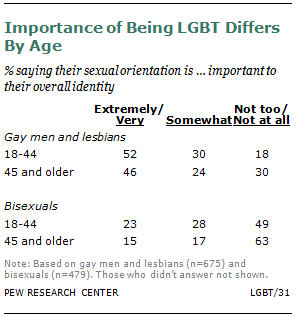
Age plays a role in the extent to which survey respondents see sexual orientation as an important aspect of their overall identity. Among gay men and lesbians, those ages 45 and older are more likely than those ages 18 to 44 to say their sexual orientation is not too or not at all important to their identity on the whole (30% vs. 18%). And a similar pattern is evident among bisexuals: 63% of bisexuals ages 45 and older say their sexual orientation is not too or not at all important to their overall identity, compared with 49% of younger bisexuals.
LGBT adults who are non-white are more likely to view their LGBT identity as very or extremely important to their overall identity: 44% of non-whites (including Hispanics) say this, compared with 34% of white LGBT adults.
While bisexuals are less likely than gay men and lesbians to view their bisexuality as important to their overall identity, this is particularly true of bisexuals who say they are more attracted to individuals of the opposite sex. Among bisexuals who say they are more attracted to the opposite sex, 64% say their bisexuality is not too or not at all important to their overall identity. By comparison, 44% of those who are either equally attracted to both sexes or more attracted to those of the same sex, say their bisexuality is not too or not at all important to their overall identity.
Is Your Sexual Orientation a Positive or Negative in Your Life?
When asked whether they think of their sexual orientation or gender identity as mainly something positive in their life today, mainly something negative or if it doesn’t make much difference either way, about six-in-ten LGBT respondents (58%) say their sexual orientation or gender identity doesn’t make much difference either way, while 34% say it is mainly something positive and just 7% say it is mainly something negative.
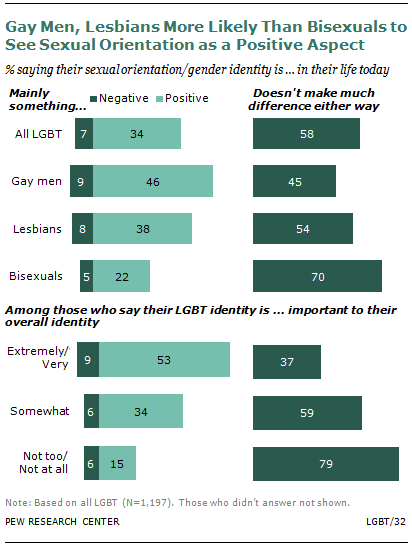
Gay men (46%) and lesbians (38%) are more likely than bisexuals (22%) to view their sexual orientation as something positive in their life today, and a small share of all groups says that their sexual orientation is something negative in their lives. Seven-in-ten bisexuals (70%) say their sexual orientation is neither something positive nor something negative.
Unsurprisingly, those who place a high level of importance on their sexual orientation or gender identity to their overall identity are also more likely to say that their sexual orientation has an impact—particularly a positive one. A 53% majority of those who say their LGBT identity is an extremely or very important part of their overall identity say that it is mainly something positive in their life today, while just 37% say it doesn’t make much difference. By contrast, 79% of those who say their LGBT identity is not too or not at all important to their overall identity say it has neither a mainly negative nor mainly positive aspect of their lives today.
While the proportion of LGBT adults who say their sexual orientation or gender identity is mainly something negative in their lives is relatively small (just 7%), this sentiment is more prevalent among some religious subgroups than others. Among LGBT Catholics, 12% say it is mainly something negative, as do 14% of LGBT evangelical Protestants (compared with just 3% of LGBT mainline Protestants). And 15% of those who attend religious services at least monthly view their sexual orientation or gender identity negatively, as do 14% of those who say religion is very important in their lives and 14% of those who see conflict between their LGBT identity and their religious beliefs.
Why Is Your LGBT Identity a Positive or Negative in Your Life?
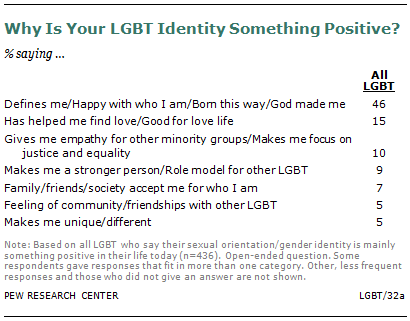
For the one-third of LGBT adults who say their sexual orientation or gender identity is mainly something positive in their lives, 46% volunteer, in an open-ended question, responses along the line of “it’s just who I am” or “how God made me.” Some (15%) say it has helped them find love or is generally good for their love life, 10% say it gives them empathy for other minority groups or makes them focus on justice and equality, and 9% say it makes them a stronger person or a role model for others in the LGBT population.
Although responses characterizing their sexual orientation as a positive because it is how they are born or made by God are about equally common among gay men, lesbians and bisexuals, bisexuals who see their sexual orientation as a positive are somewhat more likely than gay men and lesbians together to mention that their sexual orientation has helped them to find love or relationships (31% say this vs. 11% of gays and lesbians). Gay men and lesbians are more likely than bisexuals (12% vs. 3%) to say they view their sexual orientation as a positive because it makes them a stronger person or a role model for others in the LGBT population.
Voices: Why Is Your LGBT Identity Something Positive?
Defines me/Who I am/Born this way/God made me:
“Because while it’s something I must defend, it is a huge part of who I am. I love who I am, and that makes it positive.” –Lesbian, age 26
“It is who I am, and the way God created me. If this was how I was born, God must see it as good.” –Gay man, age 42
“Because it’s who I really am inside.” –Transgender adult, age 27
“It’s who I am. Why would it be other than positive?” –Lesbian, age 64
Has helped me find love/Good for love life:
“My sexual orientation has affected whom and how I love. I have been with my partner for 13 years and love him as much as always. I would not be with him otherwise.” –Gay man, age 51
“Because it opens me and my heart up to more people. Not just whom society and the past think I should be open to.” –Bisexual woman, age 32
Empathy for other minority groups/focus on equality:
“Makes it possible to better understand the problems facing blacks, women, others who are ‘closed out’ of society.” –Gay man, age 83
“Helps me be more tolerant of various differences among people—makes my horizon a little bigger—and makes me feel like part of a community.” –Bisexual woman, age 50
Makes me a stronger person/Role model for other LGBT:
“Learning how to live with discrimination and fight it makes me a stronger person.” –Lesbian, age 25
“I think I set an example. Made it easier for gays in the rural town I grew up in.” –Gay man, age 49
LGBT/32a
The sample size for those saying their LGBT identity is something negative is too small for analysis (n=71), but responses generally fell into three categories: discrimination or lack of social acceptance or understanding by some combination of society, family or friends; personal struggles, such as finding a mate, living openly, or accepting one’s own LGBT identity; and lack of legal rights.
Voices: Why Is Your LGBT Identity Something Negative?
Discrimination/lack of social acceptance:
“Judgment from others. Can’t say who I truly am, especially in Texas. Must lie to family. Hard to find others.” – Gay man, age 22
“It’s basic. The general populace discriminates against anyone who is different. Not everyone feels this way but most do. Some just don’t say anything and pretend there is no discrimination …” –Lesbian, age 49
“People assume that I will sleep with anyone I meet because I am attracted to both genders. This, of course, is not true.” –Bisexual woman, age 22
[is]
Personal struggles:
“It prevents me from living my life in the open the way other people can who are in heterosexual relationships.” –Bisexual woman, age 43
“I’m turning 50 … I wish I had a family of my own. I would turn straight if I could in order to have a family at this point in my life …” –Gay man, age 49
“My family and I are religious and it conflicts with some things that they/we believe. I am married and my husband is okay with knowing I am bisexual.” –Bisexual woman, age 22
Lack of legal rights:
“Because I cannot change or hide who I am, and it is still completely legal to discriminate and in some cases harm me just because of who I am.” –Gay man, age 32
“We are treated like second-class citizens even though we pay first-class taxes.” –Lesbian, age 55
LGBT/32a
Attraction and Sexual Orientation
Sexual orientation is not a simple subject, and it can be measured in a variety of ways. This survey relies on self-identification, while other surveys have used measures of sexual behavior or sexual attraction. For many LGB adults, particularly bisexuals, self-identification does not necessarily correspond to particular types of attraction.37
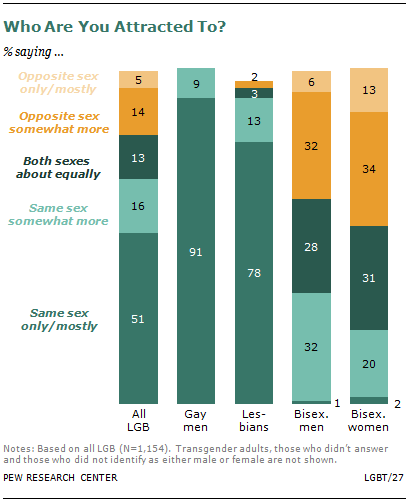
Large majorities of both gay men and lesbians say that they are primarily attracted to individuals of the same sex. Nearly all gay men say they are either only or mostly attracted to men (91%) or somewhat more attracted to men than women (9%). About three-quarters of lesbians (78%) say they are only or mostly attracted to women, and an additional 13% say they are somewhat more attracted to women, 3% say they are about equally attracted to both sexes, and 2% say they are more attracted to men.
Bisexuals express a broad range of attraction, with some notable differences between bisexual men and bisexual women. Among bisexual men, about equal shares say they are more attracted to men (34%), more attracted to women (38%) and attracted to both sexes about equally (28%). Among bisexual women, however, a plurality say they are at least somewhat more attracted to men (47%), including 13% who say they are mostly or only attracted to men; 22% of bisexual women say they are at least somewhat more attracted to women; and 31% say they are attracted to both sexes equally.
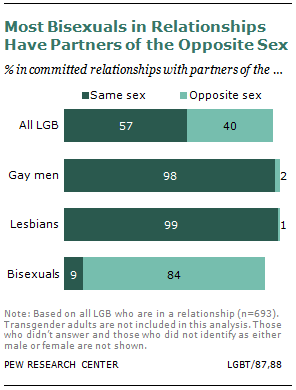
According to the survey, about half (54%) of LGB adults are in committed relationships, including 38% who are married or living with a partner. Among LGB adults in committed relationships, 57% are in same-sex relationships, 40% are in opposite-sex relationships and 2% are in relationships with someone who is transgender. Almost all gay men (98%) and lesbians (99%) in relationships have partners of the same sex, compared with about one-in-ten bisexuals (9%). Fully 84% of bisexuals who are in a committed relationship are involved with someone of the opposite sex (4% have a spouse or partner who is transgender).
Does Being LGBT Make You Different?
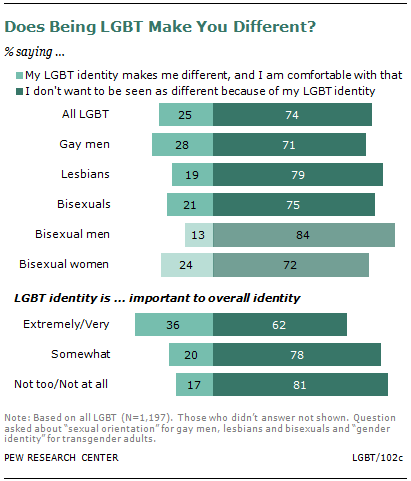
When asked which of two statements comes closer to their views—“I don’t want to be seen as different because of my sexual orientation/gender identity” or “My sexual orientation/gender identity makes me different from other people, and I am comfortable with that”—about three-quarters (74%) of LGBT adults say they don’t want to be seen as different because of their LGBT identity, and a quarter (25%) say their LGBT identity makes them different and they are comfortable with that.
Overall, majorities of all LGBT subgroups say they don’t want to be seen as different because of their LGBT identity. However, 36% of those who say that their sexual orientation or gender identity is extremely or very important to their overall identity say that their sexual orientation or gender identity makes them different and that they are comfortable with that. By comparison, among those whose sexual orientation or gender identity is less important to their overall identity, only about two-in-ten (18%) say the same.
Importance of Identity for the LGBT Population
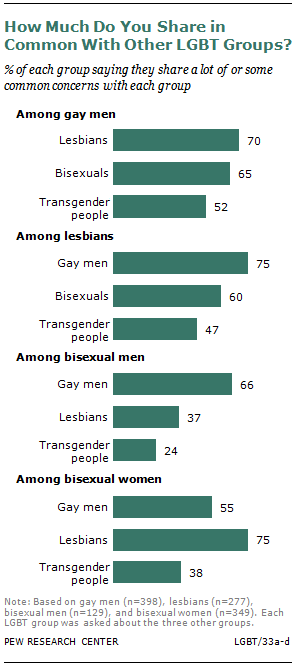
Lesbians, gay men, bisexuals and transgender adults are often described as being part of an “LGBT community,” but opinions vary about just how much each of the groups in the acronym share common concerns and identity with the other groups, how involved they are in LGBT events and issues, and how important it is to maintain a distinct LGBT culture and way of life and distinct LGBT places.
Asked how much they feel they share common concerns and identity with other groups, 70% of gay men say they feel they share a lot or some common concerns and identity with lesbians, while a similar share of lesbians (75%) say they share a lot or some in common with gay men. And about two-thirds of gay men (65%) and 60% of lesbians feel they share at least some commonalities with bisexuals. Among both gay men (52%) and lesbians (47%), fewer say they have a lot or some common concerns and identity with transgender people.
Among bisexuals, the sense of shared community with lesbians and gays is strongly linked to gender. Two-thirds of bisexual men (66%) say they have a lot or some in common with gay men, but just 37% see at least some common ground with lesbians; roughly a third (32%) say they do not share any common concerns with lesbians. Bisexual women, conversely, are more likely to say they have a lot or some in common with lesbians (75%) than with gay men (55%), and 21% say they have no common concerns with gay men.
Only about a quarter of bisexual men (24%) and about four-in-ten bisexual women (38%) say they have a lot or some in common with transgender people; pluralities of both bisexual men (51%) and bisexual women (39%) say that they feel they do not have any common concerns and identity with transgender people.38
Lesbian, gay, and bisexual respondents who feel their own sexual orientation or gender identity is an extremely or very important aspect of their overall identity are, in general, more likely to say they share commonality with most of the groups. For example, while 47% of lesbians feel a sense of commonality with transgender people, that share rises to 58% among those who say being lesbian is extremely or very important to their overall identity. One exception is commonality with bisexuals: Gay men and lesbians who view their own sexual orientation as extremely or very important to their overall identity are no more (or less) likely than other gay men or lesbians to see commonality with bisexuals.
Level of Engagement in LGBT Groups, Events, Issues
While many individuals have been involved in LGBT events or groups or have been active in support of LGBT rights and recognition, these types of activities are far from universal.
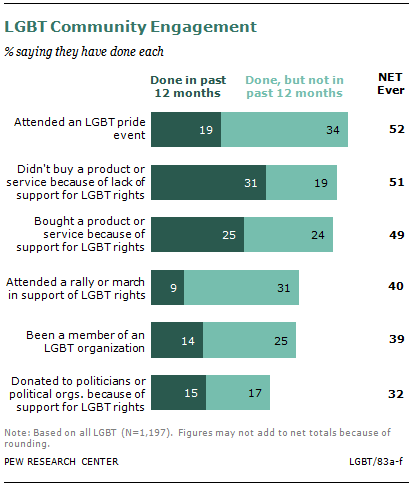
About half (52%) of survey respondents say they have attended an LGBT pride event at some point in their lives, and two-in-ten (19%) say they have done so in the past 12 months. Four-in-ten (40%) say they have attended a march or rally in support of LGBT rights, including 9% who have done so in the past year.
About four-in-ten LGBT adults (39%) say they have been a member of an LGBT organization at some point in their lives, including 14% who say they have been a part of an LGBT organization in the past year. About a third (32%) say they have donated money to politicians or political organizations because of their support for LGBT rights, including 15% over the past 12 months.
Fully half of LGBT adults say they have either expressly supported or avoided businesses because of their stance on LGBT rights: 49% say they have bought a product or service because the company is supportive of LGBT rights, while 51% say they have decided not to buy a product or service because the company is not supportive of LGBT rights. Many of these are the same people: 42% have done both.
About three-in-ten LGBT adults (31%) say they have decided not to buy from a company that is not supportive of gay rights in the past year, while 25% say they have bought a product in the past year because the company was supportive of gay rights.
The survey asked about involvement in six types of LGBT-related events or activities. Overall, 70% of respondents say they have done at least one in their lifetimes, and 46% have done at least one within the past year.
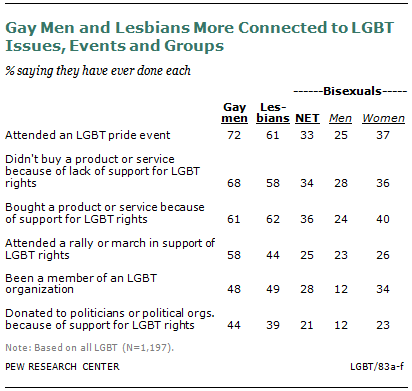
Gay men and lesbians are more likely than bisexuals to have engaged in any of these community activities. And gay men stand out even more than lesbians when it comes to LGBT pride events and rallies and marches for LGBT rights. For example, 72% of gay men have ever attended an LGBT pride event, compared with 61% of lesbians and 33% of bisexuals.
However, when looking at attendance at pride events and LGBT rights marches in the past 12 months—a period in which there have been a lot of marches and rallies surrounding the issue of same-sex marriage—there are no significant gaps between gay men and lesbians. Some 29% of gay men and 23% of lesbians have attended an LGBT pride event in the past 12 months, compared with 9% of bisexuals.
Perhaps not surprisingly, those who say their sexual orientation or gender identity is an extremely or very important aspect of their overall identity are much more likely than those for whom it is less important to have engaged in any of these activities, with the gaps ranging from 20 percentage points (for donating money to politicians or political organizations who support LGBT rights) to 31 percentage points (for buying products from companies supportive of LGBT rights).
Education and income are also strongly associated with participation in each of these activities. For example, 68% of LGBT adults with a bachelor’s degree or more have attended a pride event, compared with 45% of those without a bachelor’s degree.
Ideology and partisanship are also linked to engagement in each of these activities. Liberal and Democratic LGBT adults are more likely than others to have done each of these activities. For the most part, this relationship holds among just gay men and lesbians as well (as discussed in Chapter 7, gays and lesbians are more likely than bisexuals to be liberal or Democratic). However, there are no significant partisan differences among gay men and lesbians in attendance at rallies or pride events.
Maintaining Distinct LGBT Culture vs. Going Mainstream
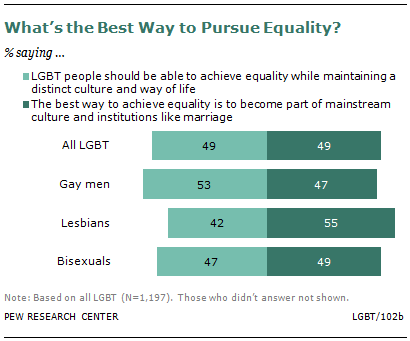
When it comes to views about the best course of action to achieve equality, LGBT adults are divided about whether they think members of the LGBT population should “be able to achieve equality while maintaining a distinct culture and way of life” or whether “the best way to achieve equality is to become part of mainstream culture and institutions like marriage” (49% say each).
There are only modest differences on this question across identity or demographic subgroups of the LGBT population
On a related question, more than half of LGBT adults (56%) say that “It is important to maintain places like LGBT neighborhoods and gay and lesbian bars,” while 41% say “these types of places will not be important as LGBT people are more accepted into society.” Gay men are the most likely LGBT group to say that maintaining distinctly LGBT places is important; 68% do so, compared with 55% of lesbians and 47% of bisexuals.
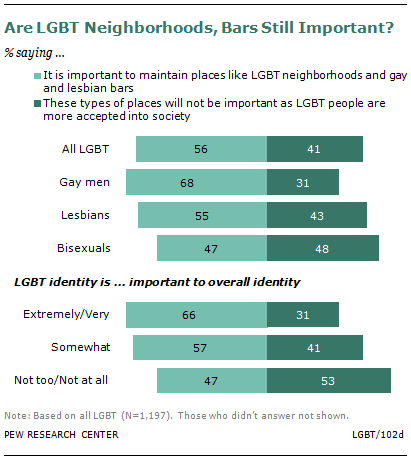
Younger LGBT adults are more likely to say maintaining these venues is important (61% of those ages 18 to 44 say this, compared with 50% of those ages 45 and older; this is especially true among younger gay men and lesbians, for whom 73% say it is important to maintain LGBT places, compared with 54% of gay men and lesbians ages 45 and older.
Those who say their sexual orientation or gender identity is extremely or very important to their overall identity are more likely than others to place importance on maintaining distinctly LGBT places (66% vs. 51%). However, the opinions of those who currently live—or those who have lived—in LGBT neighborhoods are no more likely to say these types of neighborhoods and establishments are important to maintain.




